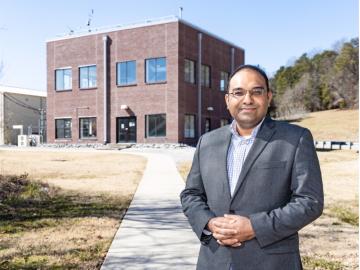
Filter News
Area of Research
- (-) Clean Energy (525)
- (-) Functional Materials for Energy (16)
- (-) Neutron Science (191)
- (-) Supercomputing (312)
- Advanced Manufacturing (34)
- Biological Systems (18)
- Biology and Environment (177)
- Biology and Soft Matter (5)
- Building Technologies (12)
- Chemical and Engineering Materials (4)
- Chemistry and Physics at Interfaces (11)
- Climate and Environmental Systems (14)
- Computational Biology (6)
- Computational Chemistry (5)
- Computational Engineering (5)
- Computer Science (19)
- Data (1)
- Earth Sciences (1)
- Electricity and Smart Grid (3)
- Energy Frontier Research Centers (14)
- Energy Sciences (5)
- Fossil Energy (3)
- Fuel Cycle Science and Technology (3)
- Fusion and Fission (55)
- Fusion Energy (19)
- Geographic Information Science and Technology (3)
- Isotope Development and Production (3)
- Isotopes (36)
- Materials (433)
- Materials Characterization (2)
- Materials for Computing (36)
- Materials Synthesis from Atoms to Systems (13)
- Materials Under Extremes (12)
- Mathematics (1)
- National Security (81)
- Neutron Data Analysis and Visualization (4)
- Nuclear Science and Technology (74)
- Nuclear Systems Modeling, Simulation and Validation (3)
- Nuclear Systems Technology (1)
- Quantum Condensed Matter (4)
- Quantum information Science (9)
- Reactor Technology (1)
- Renewable Energy (4)
- Sensors and Controls (5)
- Transportation Systems (11)
News Type
News Topics
- 3-D Printing/Advanced Manufacturing (83)
- Advanced Reactors (7)
- Artificial Intelligence (44)
- Big Data (25)
- Bioenergy (33)
- Biology (22)
- Biomedical (30)
- Biotechnology (6)
- Buildings (39)
- Chemical Sciences (17)
- Clean Water (10)
- Climate Change (35)
- Composites (18)
- Computer Science (109)
- Coronavirus (28)
- Critical Materials (12)
- Cybersecurity (15)
- Decarbonization (36)
- Energy Storage (79)
- Environment (73)
- Exascale Computing (24)
- Fossil Energy (3)
- Frontier (30)
- Fusion (3)
- Grid (42)
- High-Performance Computing (41)
- Hydropower (2)
- Isotopes (2)
- Machine Learning (21)
- Materials (57)
- Materials Science (57)
- Mathematics (3)
- Mercury (3)
- Microelectronics (1)
- Microscopy (15)
- Molten Salt (1)
- Nanotechnology (23)
- National Security (11)
- Net Zero (4)
- Neutron Science (103)
- Nuclear Energy (13)
- Partnerships (12)
- Physics (17)
- Polymers (14)
- Quantum Computing (19)
- Quantum Science (30)
- Renewable Energy (1)
- Security (10)
- Simulation (17)
- Software (1)
- Space Exploration (8)
- Statistics (1)
- Summit (43)
- Sustainable Energy (71)
- Transformational Challenge Reactor (3)
- Transportation (71)
Media Contacts

Stephen Kowalski and Mikael Salonvaara received the Distinguished Service Award, which salutes members who have served the society with distinction in chapter, regional and society activities.

Three transportation researchers at the Department of Energy’s Oak Ridge National Laboratory have been elevated to senior member grade of the Institute of Electrical and Electronics Engineers, or IEEE.

Kashif Nawaz, distinguished researcher and section head for Building Technologies Research at the Department of Energy’s Oak Ridge National Laboratory, has been named a Fellow of the American Society of Mechanical Engineers, or ASME.

The "SNS LEGO Model Middle School Outreach Program" invites middle school students to build a LEGO model of the SNS, a major scientific accelerator. This engaging initiative aims to teach students about STEM careers and the inner workings of the SNS through hands-on construction and interactive lessons. Launching next spring, the program seeks to inspire interest in science and engineering among young learners.

Nuclear physicists at the Department of Energy’s Oak Ridge National Laboratory recently used Frontier, the world’s most powerful supercomputer, to calculate the magnetic properties of calcium-48’s atomic nucleus.

Scientists at ORNL have developed 3-D-printed collimator techniques that can be used to custom design collimators that better filter out noise during different types of neutron scattering experiments

Electric vehicles can drive longer distances if their lithium-ion batteries deliver more energy in a lighter package. A prime weight-loss candidate is the current collector, a component that often adds 10% to the weight of a battery cell without contributing energy.

It would be a challenge for any scientist to match Alexey Serov’s rate of inventions related to green hydrogen fuel. But this researcher at ORNL has 84 patents with at least 35 more under review, so his electrifying pace is unlikely to slow down any time soon.

Researchers at ORNL became the first to 3D-print large rotating steam turbine blades for generating energy in power plants.

A team of computational scientists at ORNL has generated and released datasets of unprecedented scale that provide the ultraviolet visible spectral properties of over 10 million organic molecules.


